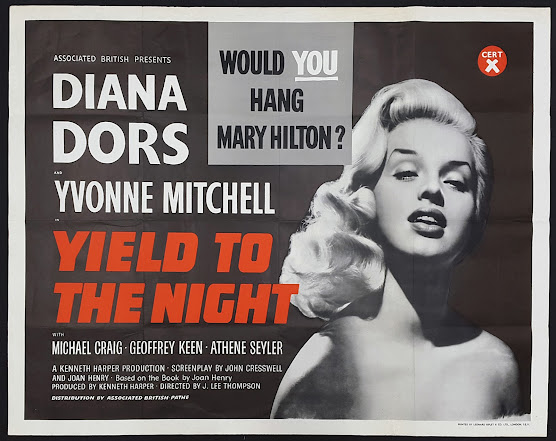Ordinary Lady Goes to Jail
Last week, I promised everyone a double-bill of "Blonde Bombshells", and true to my word, here is Bombshell #2.
On the surface, Diana Dors might seem to be an odd choice for a series about "Ordinary Ladies". Like many bombshells of the era, her public image was very carefully constructed: the platinum blonde hair; the brutal corset; the weaponised underwear - all of which added up to a "performance" of womanhood that is only remotely plausible if you define "woman" as "Barbie Doll".
It's no coincidence that Diana Dors was often described as "The English Marilyn". Like Marilyn Monroe, there was nothing natural or spontaneous about her appearance. Hours of work went into the presentation of her persona, and the end result was "woman" as "object". She was a thing, on display the visual pleasure of others, like so many sex objects before and since.
All of which is what makes Yield to the Night so surprising.
Yield to the Night was released in 1956, and tells the story of Mary Hilton, a young woman who is convicted of murder and sentenced to death (as was the norm up to that point).
At the time, many assumed that the story was a not-very-subtle reference to Ruth Ellis, a young woman who had been executed for murder a year earlier (and who became the last woman ever to be executed in the UK) however the screenplay and the novel on which it was based were both completed before the Ruth Ellis case.
Both novel and screenplay had been written by Joan Henry, a woman who had served a prison sentence (for writing bad cheques) and had written a best-selling book about her experience. That book became a very successful film in 1953 (The Weak and the Wicked; with Diana Dors in a supporting role) and its director, J Lee Thompson, suggested that they follow it up with a film about the death penalty.
Yield to the Night was a revelation to anyone who had only known Diana Dors as a "bombshell". Her performance is surprisingly subtle and nuanced; this was possibly the first time she had been given an opportunity to show the world that she could act. Everyone was used to seeing her on display, but in Yield to the Night she is exposed.
When it was released in the US, the distributors changed the name to Blonde Sinner, and attempted to bill the film as a sensationalist "sexposé" on the back of Diana Dors' reputation.
Anyone going to see the film on this basis was likely to be extremely disappointed; it is absolutely not that kind of film. It is, in fact, a very quiet, understated exploration of the Death Penalty, with a career-defining performance from Diana Dors.
We will be screening Yield to the Night at 7.30pm on Thursday, the 21st of July at the Victoria Park Baptist Church.















Comments
Post a Comment